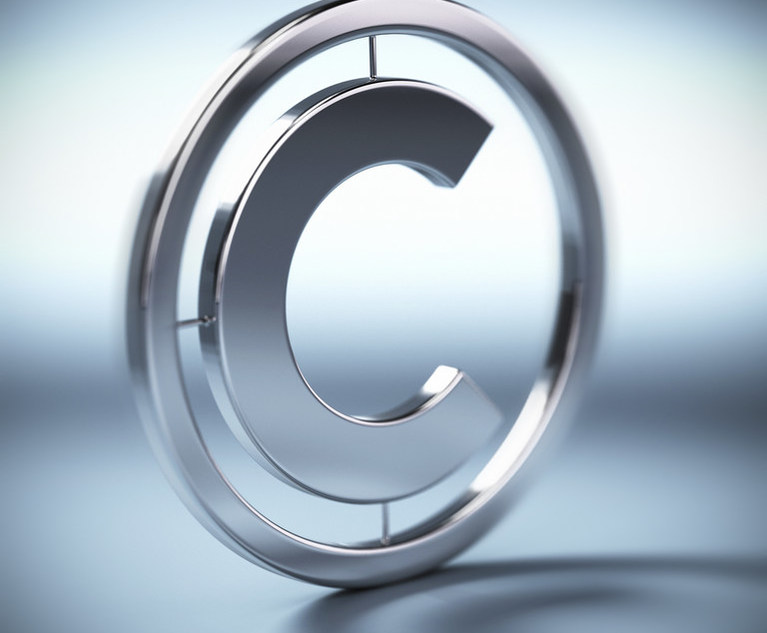Ninth Circuit Dispels De Minimis Copying Defense
The court held that the oft-cited concept of de minimis copying is not a separate defense to copyright infringement, but instead is subsumed within the determination of "substantial similarity."
October 13, 2021 at 12:00 PM
8 minute read
 On Sept. 9, 2021, in Bell v. Wilmott Storage Services, — F.4th —, 2021 WL 4097499, the U.S. Court of Appeals for the Ninth Circuit held that the oft-cited concept of de minimis copying is not a separate defense to copyright infringement, but instead is subsumed within the determination of "substantial similarity." In order to prove copyright infringement, the plaintiff must establish three elements: (1) ownership of a valid copyright, (2) copying by defendant, and (3) "substantial similarity," i.e., that defendant copied a material amount (quantitatively and qualitatively) of protected expression from plaintiff's work. In Bell, the district court granted summary judgment for defendant Wilmott on the ground that its copying was de minimis, even though the entire work had been copied. In its reversal, the Ninth Circuit stated that the District Court "misread" prior Ninth Circuit decisions using the term "de minimis," and criticized the lower court's reliance on the Second Circuit decision in Knickerbocker Toy Co. v. Azrak-Hamway Int'l, 668 F.2d 699 (2d Cir. 1982) (Knickerbocker), in which the entirety of that court's explanation for affirming the dismissal of an infringement claim was set forth in the Latin phrase "de minimis non curat lex" ("the law does not concern itself with trifles"). Unlike the District Court, however, the Ninth Circuit in Bell declined to elevate this observation to a defense.
On Sept. 9, 2021, in Bell v. Wilmott Storage Services, — F.4th —, 2021 WL 4097499, the U.S. Court of Appeals for the Ninth Circuit held that the oft-cited concept of de minimis copying is not a separate defense to copyright infringement, but instead is subsumed within the determination of "substantial similarity." In order to prove copyright infringement, the plaintiff must establish three elements: (1) ownership of a valid copyright, (2) copying by defendant, and (3) "substantial similarity," i.e., that defendant copied a material amount (quantitatively and qualitatively) of protected expression from plaintiff's work. In Bell, the district court granted summary judgment for defendant Wilmott on the ground that its copying was de minimis, even though the entire work had been copied. In its reversal, the Ninth Circuit stated that the District Court "misread" prior Ninth Circuit decisions using the term "de minimis," and criticized the lower court's reliance on the Second Circuit decision in Knickerbocker Toy Co. v. Azrak-Hamway Int'l, 668 F.2d 699 (2d Cir. 1982) (Knickerbocker), in which the entirety of that court's explanation for affirming the dismissal of an infringement claim was set forth in the Latin phrase "de minimis non curat lex" ("the law does not concern itself with trifles"). Unlike the District Court, however, the Ninth Circuit in Bell declined to elevate this observation to a defense.
Facts
In 2000, plaintiff Richard Bell (Bell), while an attorney at the Indianapolis law firm of Cohen & Malad, took a landscape photograph of the Indianapolis skyline (the "photo"), which was posted on the firm website. Bell also published the photo on "Webshots.com" and on his own online photo gallery "richbellphotos.com," from which he licensed his photographs for commercial use. In 2011, he received a certificate of copyright registration for the photo.
In 2018, by which time Bell had apparently turned his professional activities to photography and copyright litigation (having over 100 actions for infringement of the same photo), he ran a reverse image search for the photo on Google Images. This search revealed that the photo was located on a server hosting the website VisitUSA.com, which defendant Wilmott Storage Services (Wilmott) had purchased in 2012 and updated in 2014. The District Court found that, at both the time of purchase and the later update, Wilmott was likely unaware of the photo's presence on the server hosting the website.
This content has been archived. It is available through our partners, LexisNexis® and Bloomberg Law.
To view this content, please continue to their sites.
Not a Lexis Subscriber?
Subscribe Now
Not a Bloomberg Law Subscriber?
Subscribe Now
NOT FOR REPRINT
© 2025 ALM Global, LLC, All Rights Reserved. Request academic re-use from www.copyright.com. All other uses, submit a request to asset-and-logo-licensing@alm.com. For more information visit Asset & Logo Licensing.
You Might Like
View All

‘Second’ Time’s a Charm? The Second Circuit Reaffirms the Contours of the Special Interest Beneficiary Standing Rule

Attorney Fee Reimbursement for Non-Party Subpoena Recipients Under CPLR 3122(d)
6 minute readLaw Firms Mentioned
Trending Stories
- 1'It's Not Going to Be Pretty': PayPal, Capital One Face Novel Class Actions Over 'Poaching' Commissions Owed Influencers
- 211th Circuit Rejects Trump's Emergency Request as DOJ Prepares to Release Special Counsel's Final Report
- 3Supreme Court Takes Up Challenge to ACA Task Force
- 4'Tragedy of Unspeakable Proportions:' Could Edison, DWP, Face Lawsuits Over LA Wildfires?
- 5Meta Pulls Plug on DEI Programs
Who Got The Work
Michael G. Bongiorno, Andrew Scott Dulberg and Elizabeth E. Driscoll from Wilmer Cutler Pickering Hale and Dorr have stepped in to represent Symbotic Inc., an A.I.-enabled technology platform that focuses on increasing supply chain efficiency, and other defendants in a pending shareholder derivative lawsuit. The case, filed Oct. 2 in Massachusetts District Court by the Brown Law Firm on behalf of Stephen Austen, accuses certain officers and directors of misleading investors in regard to Symbotic's potential for margin growth by failing to disclose that the company was not equipped to timely deploy its systems or manage expenses through project delays. The case, assigned to U.S. District Judge Nathaniel M. Gorton, is 1:24-cv-12522, Austen v. Cohen et al.
Who Got The Work
Edmund Polubinski and Marie Killmond of Davis Polk & Wardwell have entered appearances for data platform software development company MongoDB and other defendants in a pending shareholder derivative lawsuit. The action, filed Oct. 7 in New York Southern District Court by the Brown Law Firm, accuses the company's directors and/or officers of falsely expressing confidence in the company’s restructuring of its sales incentive plan and downplaying the severity of decreases in its upfront commitments. The case is 1:24-cv-07594, Roy v. Ittycheria et al.
Who Got The Work
Amy O. Bruchs and Kurt F. Ellison of Michael Best & Friedrich have entered appearances for Epic Systems Corp. in a pending employment discrimination lawsuit. The suit was filed Sept. 7 in Wisconsin Western District Court by Levine Eisberner LLC and Siri & Glimstad on behalf of a project manager who claims that he was wrongfully terminated after applying for a religious exemption to the defendant's COVID-19 vaccine mandate. The case, assigned to U.S. Magistrate Judge Anita Marie Boor, is 3:24-cv-00630, Secker, Nathan v. Epic Systems Corporation.
Who Got The Work
David X. Sullivan, Thomas J. Finn and Gregory A. Hall from McCarter & English have entered appearances for Sunrun Installation Services in a pending civil rights lawsuit. The complaint was filed Sept. 4 in Connecticut District Court by attorney Robert M. Berke on behalf of former employee George Edward Steins, who was arrested and charged with employing an unregistered home improvement salesperson. The complaint alleges that had Sunrun informed the Connecticut Department of Consumer Protection that the plaintiff's employment had ended in 2017 and that he no longer held Sunrun's home improvement contractor license, he would not have been hit with charges, which were dismissed in May 2024. The case, assigned to U.S. District Judge Jeffrey A. Meyer, is 3:24-cv-01423, Steins v. Sunrun, Inc. et al.
Who Got The Work
Greenberg Traurig shareholder Joshua L. Raskin has entered an appearance for boohoo.com UK Ltd. in a pending patent infringement lawsuit. The suit, filed Sept. 3 in Texas Eastern District Court by Rozier Hardt McDonough on behalf of Alto Dynamics, asserts five patents related to an online shopping platform. The case, assigned to U.S. District Judge Rodney Gilstrap, is 2:24-cv-00719, Alto Dynamics, LLC v. boohoo.com UK Limited.
Featured Firms
Law Offices of Gary Martin Hays & Associates, P.C.
(470) 294-1674
Law Offices of Mark E. Salomone
(857) 444-6468
Smith & Hassler
(713) 739-1250







